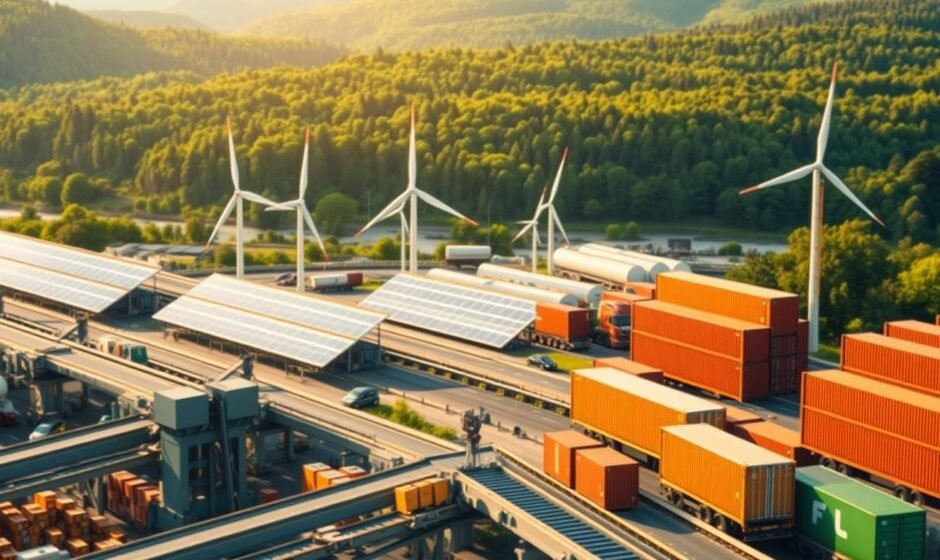Ireland plans to be carbon neutral by 2050, putting pressure on businesses to go green. This move is not just right; it’s also smart for business. Almost a third of shoppers have ditched brands for ethical or green reasons.
This shows how important it is for companies to focus on sustainability. It’s not just about doing the right thing. It’s also about keeping customers happy and boosting profits.
Green supply chains help cut costs, keep supplies flowing, and build trust with customers. Following standards like ISO 14001 and ISO 50001 can also open doors to more business opportunities. To stay ahead, using technology to track and improve sustainability efforts is key.
This article will show you how to build a sustainable supply chain. It will help your business grow and succeed in a greener world.
Key Takeaways
- By 2050, companies are expected to align their practices with net-zero emissions goals.
- Over 70% of consumers prefer buying from businesses with sustainable supply chains.
- Engaging suppliers in sustainability improves compliance with environmental regulations by up to 50%.
- Implementing sustainable practices can lead to operational cost reductions of up to 20%.
- Periodic audits of suppliers significantly enhance sustainability performance among companies.
Understanding Sustainability in Supply Chains
Embracing sustainability in supply chains means seeing how environmental, economic, and social goals are linked. It’s not just about following rules. It’s about finding ways to protect our planet and make businesses better.
The Importance of Environmental Responsibility
Environmental responsibility is key to sustainable supply chains. It includes using eco-friendly packaging and energy-saving technologies. Companies that care about the environment often save money on energy and waste.
Research shows that companies that focus on ESG factors get better financial deals. This helps them stay strong in the long run.
Economic Benefits of Sustainable Practices
Sustainable practices bring big economic wins. Companies that focus on sustainability see better productivity and cost savings. For example, Patagonia’s Denim technology uses less electricity and makes less CO2.
Such innovations boost profits and meet community and environmental needs. Companies that lead in carbon disclosure see better stock-market returns. This shows the financial benefits of being green.
The Role of Corporate Social Responsibility
Corporate social responsibility is essential in sustainable supply chains. It makes sure companies are good for society while making money. Sustainable procurement involves checking suppliers to make sure they meet standards.
Innovative campaigns, like Patagonia’s ‘Don’t buy this Jacket,’ show how sustainability messages can work. They can even increase sales. This builds trust and loyalty, improving a company’s reputation.
Assessing Current Supply Chain Practices
In today’s fast-paced world, businesses must check their supply chain practices to stay ahead. This check helps spot where things can be better and plan for a greener future. By focusing on things like emissions, waste, and green materials, companies can save money and help the planet.
Identifying Key Areas for Improvement
When you look at your supply chain, it’s important to find what needs work. A lot of a company’s carbon footprint comes from its supply chain. Also, most of its costs come from these activities. By knowing where to improve, companies can cut down on waste and save money.
Conducting a Sustainability Audit
A sustainability audit is a smart way to check your supply chain. It shows you where you’re doing well and where you can do better. Even though it’s tough for some companies to see the benefits of going green, having clear goals helps make progress.
Benchmarking Against Industry Standards
It’s key to compare your supply chain with others in your field. This lets you see how you stack up and find ways to get better. With more companies going green, keeping up with trends is important. You can learn a lot from places like Renewable Vibes.
Engaging Partners and Suppliers
Working with partners and suppliers is key to a successful supply chain. Together, you can make a big difference for the environment. This teamwork often brings new ideas and ways to cut down on waste and emissions.
Good communication and trust are vital. They help build a strong network that shares your sustainability goals.
Importance of Supplier Collaboration
Working together with suppliers is critical for a greener supply chain. Long-term partnerships lead to better sustainability results. For example, Walmart saved over 28 million metric tons of CO2, which is like taking 5.9 million cars off the road for a year.
This shows how important it is to work with others towards a greener future.
Criteria for Selecting Sustainable Suppliers
Look for suppliers who care about the environment and follow ethical practices. They should also be able to track and reduce emissions. Companies that aim for carbon neutrality are a good choice.
Sharing data with partners makes things more transparent. This helps make better decisions in the supply chain.
Having a Human Rights and Environmental Supply Chain Due Diligence Program is now essential. It helps meet new rules and builds a greener supply chain. This way, you can work with eco-friendly partners and reach your sustainability goals together.
Implementing Sustainable Sourcing Strategies
Today, using sustainable sourcing strategies is key. Choosing local resources cuts down on carbon emissions from transport. It also helps local economies and builds community ties.
Prioritising Local and Sustainable Resources
Using local resources is a big part of being sustainable. When companies buy materials near them, they cut down on transport emissions. This makes their supply chain more eco-friendly.
It also helps them work better with local suppliers. This builds a strong network of green partnerships.
Evaluating Material Life Cycles
Looking at how materials are used is also important. This helps find ways to cut waste and use greener options. It shows where waste happens and helps make better choices.
This makes a company more sustainable. It leads to better efficiency in how they work.
Responsible Procurement Policies
Having good procurement policies is key to being sustainable. These policies should encourage the use of materials that don’t harm the planet. They should also support ethical suppliers.
This makes a company’s actions match its values. It can improve their reputation and save money. Studies show green companies grow better and spend less.
By using what’s available and learning from others, you can meet your sustainability goals. For more tips on living sustainably, check out the sustainable practices guide.
Designing Efficient Logistics and Distribution
Efficient logistics and distribution are key to reducing supply chain environmental impact. By focusing on sustainability, businesses can cut down on carbon emissions and boost efficiency. This approach not only helps the planet but also improves your company’s finances.
Reducing Carbon Emissions in Transportation
To meet sustainability goals, companies need to create efficient logistics systems. This means:
- Optimising routes to use less fuel.
- Adding low-emission vehicles to the fleet.
- Using different transport methods to improve efficiency.
These steps help lower your carbon footprint and support sustainable logistics. A study on 600 companies in Europe and the U.S. shows the importance of customised strategies for logistics.
Strategies for Eco-Friendly Packaging
Creating eco-friendly packaging strategies is also essential for sustainable logistics. You can make your packaging more sustainable by:
- Choosing materials that are biodegradable and recyclable.
- Designing packaging that uses less material but keeps products safe.
- Using reusable packaging to cut down on waste.
Research shows 74% of consumers are ready to pay more for sustainable packaging. By focusing on sustainable packaging, you meet customer needs and support environmental goals. For more on sustainable supply chain practices, check out the guide on sustainable supply chain management.
Embracing Technology for Sustainability
In today’s fast-changing business world, using technology for sustainability is key. Advanced tech helps companies run better and reduce their environmental footprint. Supply chains are big emitters, so using data analytics is vital for tracking and improving sustainability.
Leveraging Data Analytics for Efficiency
Data analytics is a big help for supply chains. It lets companies see what’s coming, make quick changes, and run smoother. For example, it helps spot problems early and find solutions before they happen.
This is super important now, as we all know more about the risks in global supply chains.
Innovations in Supply Chain Management
New tech in supply chain management is changing old ways. Tools like supply chain mapping and software show where things can get better. They help companies work better with suppliers and talk more within their networks.
In 2024, we’ll see more focus on “GEN AI.” This means using AI to make things more efficient and innovative. It’s all about making supply chains smarter and greener.

| Technology | Application | Benefits |
|---|---|---|
| Data Analytics | Monitoring sustainability metrics | Enhanced decision-making |
| Supply Chain Mapping Software | Identifying inefficiencies | Streamlined operations |
| AI and IoT Integration | Proactive management of activities | Improved worker retention and efficiency |
| Predictive Analytics | Anticipating challenges | Reducing risk and optimising resources |
By using tech for sustainability, your company can work better and tackle big challenges. These steps are essential for staying ahead and helping the planet.
Training Employees on Sustainability Practices
Teaching employees about sustainability is key to making an organisation green. It’s about making everyone understand how they help the planet. This way, they feel part of a bigger goal to protect the environment.
Building a Culture of Sustainability
Creating a green culture needs effort from leaders. They must teach staff how their actions affect the planet. This makes people think about being eco-friendly at work and home.
Studies show 72% of remote workers want to help the planet. This shows they’re ready to learn and act. Organisations can use this by training them well.
Workshops and Educational Programs
Organisations can get greener by running workshops and educational programs. These cover important topics like saving energy and reducing waste. They also teach about using sustainable materials.
Research shows digital training can cut CO2 emissions by 85%. It’s a smart choice for companies caring about the environment. Keeping training going helps employees get better at their jobs. It prepares them for the green economy.
Getting people to share what they’ve learned helps everyone. Having a team focused on sustainability makes things better across the organisation.
Measuring and Reporting Sustainability Efforts
Measuring sustainability efforts is key to a responsible supply chain. By setting key performance indicators, companies can track their progress. This helps in making informed decisions.
Assessing initiatives like emissions cuts and waste reduction is essential. It shows how companies impact the environment. This way, they can see their full effect.
Key Performance Indicators to Track
Start by managing data well. Good data collection methods include:
- Implementing data-sharing agreements with partners
- Conducting regular audits to ensure compliance
- Utilising technologies like IoT sensors and blockchain
Having a clear data system is important. Use frameworks like the Global Reporting Initiative (GRI) and Sustainability Accounting Standards Board (SASB). They help track environmental, social, and governance (ESG) performance.
Integrated reporting is also key. It shows both financial and sustainability data together. This gives a full picture of a company’s value.
Impact Reporting and Transparency
Transparency in reporting builds trust. The Global Reporting Initiative (GRI) has grown a lot, with over 14,000 organisations using it. This shows how important sustainability reporting is.
Real-time ESG data helps companies make quick, smart decisions. Reports from the Carbon Disclosure Project (CDP) show over 23,000 companies are involved. They focus on big environmental issues like carbon emissions.
Companies like Ford and Unilever use specific sustainability metrics. This shows they’re serious about sustainability. British Land has been reporting its efforts for years, showing UK SMEs’ commitment.

As governments ask for more reports, keeping reports accurate and on time is critical. Better data collection leads to better sustainability efforts. This builds trust and shows companies are accountable.
Communicating Sustainability Achievements
Telling others about your green efforts helps connect your company with its stakeholders. This includes customers, investors, and the local community. Being open builds trust and strengthens bonds, encouraging people to get involved in your green projects.
How to Effectively Share Progress with Stakeholders
To better share your green wins, set clear, measurable goals. Track how much you’ve cut down on carbon emissions, energy use, and waste. Regular reports help start open talks about what you’ve done well and what you’re working on.
Using numbers to show your impact is powerful. It shows how your efforts are making a difference. For more on this, check out this guide on sustainability.
Utilising Social Media and Marketing Channels
Social media is great for showing off your green work. It lets you share your successes in a way that grabs attention. Use pictures and stories to draw people in and start conversations.
Think about running campaigns that focus on your green actions. This could be using resources better or choosing greener ways to travel. Social media can help spread the word, reaching those who care about the planet.
Understanding Regulatory and Compliance Requirements
As you explore the world of sustainability rules, knowing about regulatory requirements is key. In the US and EU, rules like the Climate Disclosure Rule are changing the game. They make public companies reveal their carbon footprint, including Scope 1, 2, and 3 emissions.
This openness helps keep supply chains in line and avoids big fines for greenwashing. The risk of fines can be up to 10% of a company’s global revenue.
Navigating Sustainability Regulations in the US
In the US, companies face growing pressure to follow sustainability rules. These rules ask for detailed reports and accountability. The UK’s Climate-related Financial Disclosure Regulations (CFDR) also require big firms to share their climate-related financial info.
This uniform rule aims to boost transparency and keep up with global standards. It helps companies stay competitive. As more sectors follow these rules, it’s vital for businesses to check their environmental impact and update their plans.
Keeping Up with Industry Guidelines
To stay on top of sustainability regulations, businesses must watch industry guidelines closely. This includes the EU’s Corporate Sustainability Reporting Directive (CSRD) and Germany’s Supply Chain Due Diligence Act. Working with peers and using data analytics tools can make compliance easier.
As rules focus more on social and environmental issues, being proactive is more important than ever. Following these guidelines helps your company and the planet thrive in the future.



